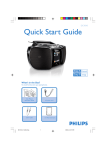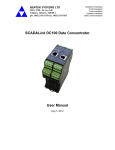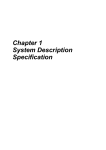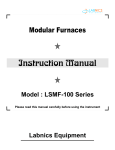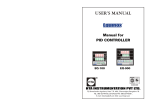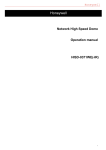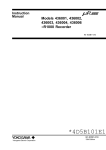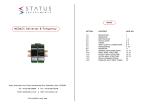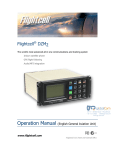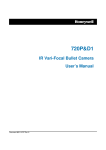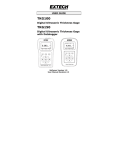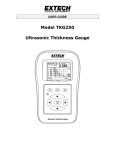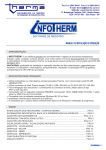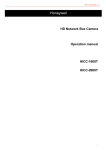Download Product Manual - Dominion Industrial
Transcript
DC1000 Series Digital Controller Product Manual 51-52-25-113 August 2005 Industrial Measurement and Control Copyright, Notices and Trademarks Printed in Taiwan - © Copyright 2005 by Honeywell Revison 1 - August 2005 WARRANTY/REMEDY Honeywell warrants goods of its manufacture as being free of defective materials and faulty workmanship. Contact your local sales office for warranty information. If warranted goods are returned to Honeywell during the period of coverage, Honeywell will repair or replace without charge those items it finds defective. The foregoing is Buyer's sole remedy and is in lieu of all other warranties, expressed or implied, including those of merchantability and fitness for a particular purpose. Specifications may change without notice. The information we supply is believed to be accurate and reliable as of this printing. However, we assume no responsibility for its use. While we provide application assistance personally, through our literature and the Honeywell web site, it is up to the customer to determine the suitability of the product in the application. Industrial Measurement and Control Honeywell Korea 191 HanGangRo 2ga, YongSanGu Seoul, Korea ii DC1010/1020/1030/1040 Product Manual 8/05 About This Document Abstract This document provides descriptions and procedures for the Installation, Configuration, and Operation of your DC1000 Controller. Contacts World Wide Web The following lists Honeywell’s World Wide Web sites that will be of interest to our customers. Honeywell Organization WWW Address (URL) Corporate http://www.honeywell.com Industrial Measurement and Control http://www.honeywell.com/imc Telephone Contact us by telephone at the numbers listed below. Organization Phone Number United States and Canada Honeywell 1-800-423-9883 1-800-525-7439 Asia Pacific Asia Pacific Headquarters (63-2) 633 2830 Europe Honeywell PACE, Brussels, Belgium Contact your Local Sales Office Latin America Honeywell, Ft. Washington, PA U.S.A. 215-641-3610 8/05 DC1010/1020/1030/1040 Product Manual Tech. Support Service iii Introduction Symbol Definitions The following table lists those symbols used in this document to denote certain conditions. Symbol Definition This CAUTION symbol on the equipment refers the user to the Product Manual for additional information. This symbol appears next to required information in the manual. WARNING PERSONAL INJURY: Risk of electrical shock. This symbol warns the user of a potential shock hazard where HAZARDOUS LIVE voltages greater than 30 Vrms, 42.4 Vpeak, or 60 VDC may be accessible. Failure to comply with these instructions could result in death or serious injury. ATTENTION, Electrostatic Discharge (ESD) hazards. Observe precautions for handling electrostatic sensitive devices Protective Earth (PE) terminal. Provided for connection of the protective earth (green or green/yellow) supply system conductor. Functional earth terminal. Used for non-safety purposes such as noise immunity improvement. NOTE: This connection shall be bonded to protective earth at the source of supply in accordance with national local electrical code requirements. Earth Ground. Functional earth connection. NOTE: This connection shall be bonded to Protective earth at the source of supply in accordance with national and local electrical code requirements. Chassis Ground. Identifies a connection to the chassis or frame of the equipment shall be bonded to Protective Earth at the source of supply in accordance with national and local electrical code requirements. Equipment protected throughout by DOUBLE INSULATION or REINFORCED INSULATION iv DC1010/1020/1030/1040 Product Manual 8/05 Introduction Contents 1 INTRODUCTION ................................................................................................... 1 1.1 2 Overview.........................................................................................................................................1 INSTALLATION..................................................................................................... 3 2.1 Overview.........................................................................................................................................3 2.2 Condensed Specifications ...............................................................................................................4 2.3 Model Number Interpretation .........................................................................................................6 2.4 Mounting.........................................................................................................................................8 2.4.1 Physical Considerations .......................................................................................................8 2.4.2 Overall Dimensions..............................................................................................................8 2.4.3 Mounting Procedure...........................................................................................................10 2.5 Wiring ...........................................................................................................................................11 2.5.1 Electrical Considerations ...................................................................................................11 2.6 Wiring Diagrams...........................................................................................................................12 2.6.1 Identify Your Wiring Requirements ..................................................................................12 2.6.2 Making Terminal Connections...........................................................................................12 2.6.3 Wiring Diagrams................................................................................................................13 3 OPERATION........................................................................................................ 17 3.1 Overview.......................................................................................................................................17 3.2 Operator Interface Overview ........................................................................................................17 3.2.1 Displays, LEDs, and Keys .................................................................................................18 3.3 Mode Access.................................................................................................................................19 3.3.1 How to move from one mode to another............................................................................19 3.4 Operation Mode ............................................................................................................................20 3.4.1 Key Functions ....................................................................................................................20 3.4.2 Operation Mode Prompts ...................................................................................................20 3.4.3 Control Types.....................................................................................................................21 3.4.4 Set Point .............................................................................................................................22 3.4.5 Alarm Functions and Associated Prompts .........................................................................23 4 CONFIGURATION............................................................................................... 24 4.1 Introduction...................................................................................................................................24 4.2 Configuration 1 .............................................................................................................................24 4.2.1 Configuration 2 ..................................................................................................................26 4.3 ALARMS CONFIGURATION ....................................................................................................29 4.3.1 Alarm Function Selections.................................................................................................29 4.3.2 Deviation Alarm Overview ................................................................................................30 4.3.3 Absolute Value Alarm Overview.......................................................................................32 4.3.4 Program Alarm...................................................................................................................33 8/05 DC1010/1020/1030/1040 Product Manual v Introduction 4.3.5 System Alarm.....................................................................................................................33 4.4 Function Lock ...............................................................................................................................34 4.5 Parameter Display Set (Hide or Display)......................................................................................35 4.5.1 Overview............................................................................................................................35 4.5.2 Functions of SETs..............................................................................................................35 4.6 Input Codes ...................................................................................................................................37 4.6.1 Code Selection ...................................................................................................................37 5 PROGRAMMER (OPTIONAL) ............................................................................ 41 5.1 Overview.......................................................................................................................................41 5.1.1 Introduction........................................................................................................................41 5.2 Programmer Terminologies ..........................................................................................................41 5.3 Operating Key Functions ..............................................................................................................41 5.4 Program Functions ........................................................................................................................41 5.4.1 Program Running Alarm ....................................................................................................41 5.4.2 Segment Completion Alarm...............................................................................................42 5.4.3 END Function ....................................................................................................................42 5.4.4 Linking Function................................................................................................................42 5.4.5 Wait Function.....................................................................................................................42 5.4.6 Other Functions..................................................................................................................43 5.5 Program Configuration Prompts ...................................................................................................44 5.5.1 Overview............................................................................................................................44 5.5.2 Configuration .....................................................................................................................44 5.5.3 Program Example...............................................................................................................47 6 ERROR CODES .................................................................................................. 48 6.1 Overview.......................................................................................................................................48 7 INDEX .................................................................................................................. 49 vi DC1010/1020/1030/1040 Product Manual 8/05 Introduction Tables Table 2-1 Condensed Specifications _____________________________________________________ 4 Table 3-1 Displays, LEDs, and Keys ____________________________________________________ 18 Table 3-2 Mode Change Instructions ____________________________________________________ 19 Table 3-3 Operation Mode Prompts _____________________________________________________ 20 Table 4-1 Configuration 1 Mode________________________________________________________ 24 Table 4-2 Configuration 2 Mode________________________________________________________ 26 Table 4-3 Alarm Function Selections ____________________________________________________ 29 Table 4-4 Functions of Sets____________________________________________________________ 35 Table 4-5 Thermocouple Inputs ________________________________________________________ 37 Table 4-6 RTD Inputs ________________________________________________________________ 38 Table 4-7 Linear Inputs _______________________________________________________________ 39 Table 5-1 Key Functions ______________________________________________________________ 41 Table 5-2 Associated Program Functions _________________________________________________ 43 Table 5-3 Program Configuration Prompts ________________________________________________ 44 Table 6-1 Error Codes ________________________________________________________________ 48 8/05 DC1010/1020/1030/1040 Product Manual vii Introduction Figures Figure 2-1 Model DC1010 Dimensions ___________________________________________________ 8 Figure 2-2 Model DC1020 Dimensions ___________________________________________________ 8 Figure 2-3 Model DC1030 Dimensions ___________________________________________________ 9 Figure 2-4 Model DC1040 Dimensions ___________________________________________________ 9 Figure 2-5 Mounting Procedure ________________________________________________________ 10 Figure 2-6 Model DC1010 Wiring ______________________________________________________ 13 Figure 2-7 Model DC1020, DC1025 Wiring ______________________________________________ 14 Figure 2-8 Model DC1030 Wiring ______________________________________________________ 15 Figure 2-9 Model DC1040 Wiring ______________________________________________________ 16 Figure 3-1 Operator Interface __________________________________________________________ 17 Figure 3-2 Mode Access Diagram_______________________________________________________ 19 Figure 4-1 Deviation Alarms___________________________________________________________ 30 Figure 4-2 Upper Limit Deviation Alarm (Alarm Code 01, Alarm release in the first alarming situation) ___ 30 Figure 4-3 Upper Limit Deviation Alarm (Alarm Code 11, No alarm release in the first alarming situation) _ 30 Figure 4-4 Lower Limit Deviation Alarm (Alarm Code 02, Alarm release in the first alarming situation) ___ 31 Figure 4-5 Lower Limit Deviation Alarm (Alarm Code 12, No alarm release in the first alarming situation) _ 31 Figure 4-6 Dev. Band Breakaway Alarm (Alarm Code 03, Alarm release in the first alarming situation) ____ 31 Figure 4-7 Dev. Band Breakaway Alarm (Alarm Code 13, No alarm release in the first alarming situation) __ 31 Figure 4-8 Deviation Band Alarm (Alarm Code 04, Alarm release in the first alarming situation) _________ 31 Figure 4-9 Deviation Band Alarm (Alarm Code 14, No alarm release in the first alarming situation) _______ 31 Figure 4-10 Absolute Value Alarm ______________________________________________________ 32 Figure 4-11 Absolute Upper Limit Alarm (Alarm Code 05, Alarm release in the first alarming situation) ___ 32 Figure 4-12 Absolute Upper Limit Alarm (Alarm Code 15, No alarm release in the first alarming situation) _ 32 Figure 4-13 Absolute Lower Limit Alarm (Alarm Code 06, Alarm release in the first alarming situation)___ 32 Figure 4-14 Absolute Lower Limit Alarm (Alarm Code 16, No alarm release in the first alarming situation) 32 Figure 4-15 Program RUN Alarm – Code 17 ______________________________________________ 33 Figure 4-16 System Error Alarm – Code 08 _______________________________________________ 33 Figure 4-17 System Error Alarm – Code 18 _______________________________________________ 33 Figure 4-18 Display Status ____________________________________________________________ 35 Figure 5-1 Program Example __________________________________________________________ 47 viii DC1010/1020/1030/1040 Product Manual 8/05 Introduction 1 Introduction 1.1 Overview Function The DC1000 family of microprocessor-based controllers combine a high degree of functionality and reliability in 4 different formats: 1/16 DIN, 1/8 DIN, 3/16 DIN, and 1/4 DIN. With a typical accuracy of ± 0.5% of span, the DC1000 is an ideal controller for regulating temperature and other process variables in a variety of applications including dryers, semiconductor packaging & testing, plastic processing, packaging machinery, painting & coating, and climatic chambers. Easy to Configure Two different configuration levels provide easy access to parameters. A 4-digit security code prevents unauthorized changes. Parameters can also be hidden to the user to prevent unauthorized configuration of the unit. Various Control Algorithms The DC1000 series of controllers provides several different algorithms: • • • • • PID or ON/OFF Control Hear/Cool Algorithms with 2 different PID sets Motor Position Control without slidewire feedback Single Phase Control with/without zero crossover control Three Phase Control with/without zero crossover control Mount Anywhere The DC1000 controller family is industrial control equipment that must be panel mounted. The wiring terminals must be enclosed within the panel. The DC1000 is environmentally hardened and, when suitably enclosed, can be mounted virtually anywhere in a plant or factory; on a wall, in a panel, or even on the process machine. It withstands ambient temperature of up to 50°C (122°F). 8/05 DC1010/1020/1030/1040 Product Manual 1 Introduction CE Conformity (Europe) This product is in conformity with the protection requirements of the following: European Council Directive; 73/23/EEC - the Low Voltage Directive, and 89/336/EEC the EMC Directive. Conformity of this product with any other “CE Mark” Directive(s) shall not be assumed. Enclosure Rating: Panel-mounted equipment, IP00. This controller must be panel mounted. Terminals must be enclosed within panel. Front panel IP65 (IEC 529) optionally. 2 DC1010/1020/1030/1040 Product Manual 8/05 Installation 2 Installation 2.1 Overview Introduction Installation of the DC1000 consists of mounting and wiring the controller according to the instructions given in this section. Read the pre-installation information, check the model number interpretation (Subsection 2.3), and become familiar with your model selections, then proceed with installation. CAUTION Installation should be performed only by personnel who are technically competent to do so. Local Regulations regarding electrical & safety must be observed. Pre-installation Information If the controller has not been removed from its shipping carton, inspect the carton for damage then remove the controller. 8/05 • Inspect the unit for any obvious shipping damage and report any damage due to transit to the carrier. • Make sure a bag containing mounting hardware is included in the carton with the controller. • Check that the model number shown on the inside of the case agrees with what you have ordered. DC1010/1020/1030/1040 Product Manual 3 Installation 2.2 Condensed Specifications Honeywell recommends that you review and adhere to the operating limits listed in Table 2-1 when you install your controller. Table 2-1 Condensed Specifications TECHNICAL DATA TC (K, J, R, S, B, E, N, T, W, PL II, U, L) Type of Input RTD (Pt100Ω, JPt100Ω, JPt50Ω) PV Input Indication Control Mode Output Alarm Aux. Output nd 2 Input (RSP) Program Communication Linear (4 – 20mA) Input Sampling Time 500 ms Input Resolution 14 bit (each) PV/SP Indication 4-digit, 7 segment display Constant Value Storage System Non-volatile memory (EEPROM) Indication Accuracy ± 0.5%FS Proportional Band (P) 0~200% (On/Off action at P=0) Integral Time (I) 0~3600 sec (PD action at I=0) Derivative Time (D) 0~900 sec (PI action at D=0) Cycle Time 0~150 sec (4~20mAÆ 0, SSRÆ1, relayÆ10) Relay Output Contact, SPST(DC1010)/SPDT(1020,1030,1040), 3A/240VAC Voltage Output Voltage Pulse, 20VDC/20mA Linear Output 4~20mA, 0~5V, 0~10V, 1~5V, 2~10V Motor Control Output Three Position Step Control (Time proportional motor control) Others 1ϕ SSR, 3ϕ SSR, 1ϕ SCR, 3ϕ SCR Channel 3 channels (optional) Mode 17 alarm mode available Timer Flicker alarm, continued alarm, on delay timer alarm Output Signal SP, PV Type of Output 4~20mA, 0~20mA, 0~5V, 0~10V, 1~5V, 2~10V Type of Input 4~20mA, 0~20mA, 0~5V, 0~10V, 1~5V, 2~10V Sampling Time 500 ms Pattern/Segment 2 pattern/ 8 segment (each) Availability Pattern link & repeat, program/segment end alarm Type of Communication RS-232, RS-485 Rated Power Supply Voltage & Frequency 4 AC 100-240V, 50/60Hz or DC15-50V, 4VA General Power Consumption Max. 8VA Specifications Storage Temperature -25°C~65°C Ambient Temperature 0°C~50°C Ambient Humidity 50~85% RH (no condensation) DC1010/1020/1030/1040 Product Manual 8/05 Installation INPUT ACTUATIONS TC RTD Linear 8/05 K 0.0~200.0, 400.0, 600, 800, 1000, 1200 °C J 0.0~200.0, 400.0, 600, 800, 1000, 1200 °C R 0.0~1600, 1769 °C S 0.0~1600, 1769 °C B 0.0~1820 °C E 0.0~800, 1000 °C N 0.0~1200,1300 °C T 0.0~400.0, 200.0 °C, 0.0~350.0 °C W 0.0~2000, 2320 °C PL II 0.0~1300, 1390 °C U -199.9~600.0, 200.0 °C, 0.0~400.0 °C L 0.0~400.0, 800.0 °C Pt100 -199.9~600.0, 400.0, 200.0 °C, 0.0~200.0, 400.0, 600.0 °C JPt100 -199.9~600.0, 400.0, 200.0 °C, 0.0~200.0, 400.0, 600.0 °C JPt50 -199.9~600.0, 400.0, 200.0 °C, 0.0~200.0, 400.0, 600.0 °C AN4 0~50mV 0~20mA, 0~1V, 0~5V, 0~10V AN5 10~50mV 4~20mA, 1~5V, 2~10V DC1010/1020/1030/1040 Product Manual 5 Installation 2.3 Model Number Interpretation Introduction Write your controller’s model number in the spaces provided below and circle the corresponding items in each table. This information will also be useful when you wire your controller. Instructions Select the desired Key Number. The arrow to the right marks the selections available. Make one selection each from Tables I through III using the column below the proper arrow. A dot ( ) denotes unrestricted availability. A letter denotes restricted availability. Key Numbers I II I II DC10_ _ _ _ - _ _ _ - _ _ _ - _ KEY NUMBER Description Size Power Program Input Selection 48 x 48 mm (DIN) 1/16) DC1010_ _ 48 x 96 mm (DIN 1/8) DC1020_ _ 72 x 72 mm DC1030_ _ 96 x 96 (DIN 1/4) DC1040_ _ 90-240 Vac Power DC10_0_ _ 15-50 Vdc Power DC10_1_ _ 90-240 Vac Power / IP 65 DC10_2_ _ 15-50 Vac Power / IP65 DC10_3_ _ 90-240 Vac Power / UL Agency Approval DC10_4_ _ 15-50 Vdc Power / UL Agency Approval DC10_5_ _ None DC10_ _C_ Program (2 patterns, 8 segments per 1 pattern) DC10_ _P_ RTD DC10_ _ _R TC DC10_ _ _T Linear DC10_ _ _L Availability b b b b b b b b b b b b c d c g j TABLE I Control Output 1 None 1__ Volt, Voltage Pulse, 20VDC / 20 mA 2__ mA Current, 4-20mA 3__ Open loop circuit servo motor control 7__ 0-5 V A__ 0-10 V B__ 1-5 V C__ 2-10 V D__ Control Output 2 None _0_ (Heat/Cool) Relay, Contact, SPDT, 3A / 240VAC _1_ Volt, Voltage Pulse, 20VDC / 20mA _2_ Alarm Event 6 0__ Relay, Contact, SPDT, 3A / 240 VAC mA Current, 4-20mA _3_ 0-5V _A_ 0-10V _B_ 1-5V _C_ 2-10V _D_ 1 Alarm Relay __1 e 2 Alarm Relays __2 f 3 Alarm Relays __3 DC1010/1020/1030/1040 Product Manual i h k 8/05 Installation Availability DC10_ _ _ _ 10 Table II 20 30 40 Selection Transmitter Remote SP Communication None 0__ 4-20 mA 1__ 0-20 mA 2__ 0-5 V A__ 0-10 V B__ 1-5 V C__ 2-10 V D__ None _0_ 4-20 mA _1_ l l l 0-20 mA _2_ l l l 0-5 V _A_ l l l 0-10 V _B_ l l l 1-5 V _C_ l l l 2-10 V _D_ l l l None __0 RS-232 __1 m n RS-485 __2 m n TABLE III Manual English E Chinese C French F Korean K RESTRICTIONS / NOTES Restriction Letter Available Only With Table Selection b c I _ 0 1, _ 0 2 d I & II DC10 _ _ _ _ - _ 0 1 - _ 0 _ - _ Not Available With Table Selection II X__ e I & II DC10_ _ _ _ - _ X _ - 0 _ 2 - _ f I & II DC10_ _ _ _ - _ X _ - X _ 0 - _ g I & II DC10_ _ _ _ - _ X _ - X _ _ - _ II X_X I & II DC10_ _ _ _ - _ X _ - _ X _ - _ h I & II DC10_ _ _ _ - _ 0 _ - 0 _ 0 - _ j I & II DC10_ _ _ _ - _ 0 _ - _ 0 _ - _ k I & II DC10_ _ _ _ - _ 0 _ - _ _ 0 - _ i l DC10_ _ _ P m II X__ n II _X_ * X : Option Selected 0 : Option Not Selected 8/05 DC1010/1020/1030/1040 Product Manual 7 Installation 2.4 2.4.1 Mounting Physical Considerations The controller can be mounted on either a vertical or tilted panel using the mounting bracket supplied. Adequate access space must be available at the back of the panel for installation and servicing activities. • 2.4.2 Overall dimensions and panel cutout requirements for mounting the controller are shown in Figure 2-1 through.Figure 2-4 Overall Dimensions Figure 2-1 Model DC1010 Dimensions Figure 2-2 Model DC1020 Dimensions 8 DC1010/1020/1030/1040 Product Manual 8/05 Installation Figure 2-3 Model DC1030 Dimensions Figure 2-4 Model DC1040 Dimensions 8/05 DC1010/1020/1030/1040 Product Manual 9 Installation 2.4.3 Mounting Procedure Before mounting the controller, refer to the nameplate on the outside of the case and make a note of the model number. It will help later when selecting the proper wiring configuration. d e c 1. Put the mounting bracket in the rail on the top & bottom of the case. 2. Bend the grip of the bracket & slide the bracket along the rail until the case is secured against the panel. 3. Put the grip of the bracket on the groove to fasten the case to the panel. Side View Figure 2-5 Mounting Procedure 10 DC1010/1020/1030/1040 Product Manual 8/05 Installation 2.5 2.5.1 Wiring Electrical Considerations Precautions The controller is considered “rack and panel mounted equipment” per EN61010-1, Safety Requirements for Electrical Equipment for Measurement, Control, and Laboratory Use, Part 1: General Requirements. Conformity with 72/23/EEC, the Low Voltage Directive requires the user to provide adequate protection against a shock hazard, The user shall install this controller in an enclosure that prevents the OPERATOR access to the rear terminals. Mains Power Supply This controller is suitable for connection to 100-240 Vac, 50/60 Hz or 15-50 Vdc, power supply mains. It is the user’s responsibility to provide a switch and non-time delay (North America), quick-acting, high breaking capacity, Type F(Europe), 1/2A, 250V fuse(s) or circuit breaker for 100-240Vac operation as part of the installation. The switch or circuitbreaker should be located close to the controller, within easy reach of the operator. The switch or circuit-breaker should be marked as the disconnecting device for the controller. When applying power to multiple instruments, make sure that sufficient current is supplied. Otherwise, the instruments may not start up normally due to the voltage drop caused by the in-rush current. Applying 100-240Vac to a controller rated for 15-50Vdc will severely damage the controller and is a fire and smoke hazard 8/05 DC1010/1020/1030/1040 Product Manual 11 Installation 2.6 2.6.1 Wiring Diagrams Identify Your Wiring Requirements To determine the appropriate diagrams for wiring your controller, refer to the model number interpretation in this section. The model number of the controller is on the outside of the case. Shielded twisted pair cable are required for all Analog I/O, Process Variable, RTD, Thermocouple, dc millivolt, low level signal, mA, Digital Output, and computer interface circuits. 2.6.2 Making Terminal Connections (1) Connection of power supply input terminal • Type: Round • Cable square: 1.25 mm(0.049 in) • Diameter: 3.0 ~ 3.7 mm(0.118~ 0.145 in) R1.5 1.25 5 Terminal with tube(R, 1.25 * M3) • 12 Tighten the terminal screws using a torque between 0.8 N_ m or less. DC1010/1020/1030/1040 Product Manual 8/05 Installation 2.6.3 Wiring Diagrams N Noise Filter POWER 1 L 2 AC 100 ~ 240V (50 / 60Hz) 3 4 9 14 10 PV OUTPUT Relay Volt Linear 2 8 13 5 1 7 12 DC 15 ~ 50V (option) O U T2 6 11 2 3 3 Linear O U T1=5 7 11 G 1 A,B,C ,D Relay Volt Linear 4 1 2 3 TC 7 7 8 8 B 8 12 K1 13 G 2 O U T1 R TD 14 K2 9 B 9 9 10 A 10 10 ALARM 5 A,B,C ,D AL1 AL1 AL2 2 11 13 3 12 14 O U T1=7 2 3 C LO SE AUX. OUT TRS 11 4 O PEN COMM. CO M M RS232 RD 11 12 5 CO M SD SG 12 13 CO M M RS485 D- D+ 11 12 13 Figure 2-6 Model DC1010 Wiring 8/05 DC1010/1020/1030/1040 Product Manual 13 Installation L 1 11 2 12 3 13 4 14 5 15 6 16 7 17 8 18 9 19 10 20 Linear R TD Noise Filter POWER N AC 100 ~ 240V (50 / 60Hz) DC 15 ~ 50V (option) PV OUTPUT OUT2 6 R elay Volt Linear 1 2 3 17 TC 17 17 18 18 B 18 7 A,B ,C ,D OUT1 19 B 19 19 20 A 20 20 R elay Volt Linear 8 9 NO1 2 3 NC 10 COM ALARM AL1 A,B ,C ,D 3 NC AUX. OUT AL2 NC AL3 11 6 11 TRS O U T1=7 6 4 NO NO 5 COM COM 12 7 12 13 13 7 C LO SE 8 O PEN 9 10 C O M INPUT2 14 15 16 COMM. COM M RS232 RD SD SG 14 15 16 COM M RS485 D- D+ 14 15 16 Figure 2-7 Model DC1020, DC1025 Wiring 14 DC1010/1020/1030/1040 Product Manual 8/05 Installation L Noise Filter POWER N AC 100 ~ 240V (50 / 60Hz) DC 15 ~ 50V (option) 1 15 8 2 16 9 3 17 10 4 18 11 5 19 12 6 20 13 7 21 14 PV OUTPUT O U T2 3 Relay Volt Linear 1 2 3 4 A,B,C ,D O U T1 Relay Volt Linear 5 6 NO1 2 3 Linear O U T1=5 R TD 11 15 G 1 TC 11 11 12 12 B 12 17 G 2 19 13 B 13 13 14 A 14 14 PRO T 20 NC 7 COM O U T1=7 ALARM AL1 COM 3 A,B,C ,D O U T1=8 3 15 G 1 4 C LO SE 16 K1 5 O PEN 17 G 2 6 18 K2 NO 4 8 18 9 19 NC 10 INPUT2 7 CO M AUX. OUT TRS AL2 Rem ote SP 9 20 10 COMM. CO M M RS232 RD SD 15 16 PRO T 21 SG 17 CO M M RS485 D- D+ 15 16 17 Figure 2-8 Model DC1030 Wiring 8/05 DC1010/1020/1030/1040 Product Manual 15 Installation L Noise Filter POWER N 1 31 11 COMM. 2 32 12 COMM RS232 3 33 13 4 34 14 5 35 15 6 36 16 7 37 17 8 38 18 9 39 19 10 40 20 RD AC 100 ~ 240V (50 / 60Hz) DC 15 ~ 50V (option) OUTPUT OUT2 Relay Volt Linear 1 6 2 3 OUT1=6 31 RG 32 RG OUT1 Relay Volt Linear 1 8 NO 2 3 9 NC 35 TG1 39 37 TG2 40 10 COM OUT1=7 A,B,C,D 40 OUT1=8 33 G2 7 CLOSE 32 K1 34 K2 8 OPEN 33 G2 35 G3 9 10 COM 40 PV INPUT Linear RTD 17 17 17 18 18 19 19 20 A 20 20 ALARM AL1 AL2 AL3 4 NO NO 7 5 NC 11 COM 14 39 6 12 COM INPUT2 36 K3 35 13 COMM. COMM RS232 RD 14 15 SD 16 SG 16 15 COMM RS485 D- D+ 14 15 16 PROT PROT 36 B Remote SP 34 K2 TC 19 3 NC 32 K1 31 G1 33 39 18 31 G1 6 32 D+ B OUT1=9 PROT 32 TRS PROT 39 31 D- AUX. OUT 33 G2 2 A,B,C,D 31 SG 33 31 G1 1 7 OUT1=5 SD COMM RS485 40 Figure 2-9 Model DC1040 Wiring 16 DC1010/1020/1030/1040 Product Manual 8/05 Operation 3 Operation 3.1 Overview This section gives you all the information necessary to help you monitor and operate your controller including an Operator Interface overview, an explanation of the Displays, keys, and LEDs, and Mode access, and Operation Modes. 3.2 Operator Interface Overview Figure 3-1 is a view of the operator interface. See Table 3-1 for a description of Displays, LEDs, and Keys. Also, see section 4.5 to allow parameters to be hidden or diplayed. Upper Display Lower Display LEDs Bar Graph SHIFT key 0% 20 40 60 80 100% SET key Up key A/M key Down key Figure 3-1 Operator Interface 8/05 DC1010/1020/1030/1040 Product Manual 17 Operation 3.2.1 Displays, LEDs, and Keys Table 3-1 Displays, LEDs, and Keys Displays Upper Display 4 digits dedicated to display the PV. In configuration mode, this display indicates the name of a parameter. Lower Display 4 digits dedicated to display the SP. In configuration mode, this display indicates the value of a parameter or the status of the parameter selected Bargraph A 10 green LEDs’ bargraph indicates the value of the output in percentage LEDs Indications OUT 1 Status of ‘Output 1’ OUT 2 Status of ‘Output 2’ AT When the LED is ON, it indicates that the controller is doing automatic tuning. AL 1 Status of ‘Alarm 1’ AL 2 Status of ‘Alarm 2’ AL 3 Status of ‘Alarm 3’ MAN When the LED is ON, it indicates that the controller is in manual mode. PRO When a program is running, the LED flickers When a program is suspended, the LED is ON When no program is running, the LED is OFF Keys SET SET key allows moving from one parameter to another or saving a new value of a parameter or the status of a parameter changed. A/M A/M key allows switching from automatic mode to manual mode or from manual mode to automatic mode. SHIFT UP DOWN 18 Function SHIFT key allows shifting the digits to modify parameters. Up key allows increasing the value of a digit selected or changing the status of a parameter. DOWN key allows decreasing the value of a digit selected or changing the status of a parameter. DC1010/1020/1030/1040 Product Manual 8/05 Operation 3.3 Mode Access Operation (1) Configuration 1 (2) (3) Program (2) Configuration 2 (3) Set Up Figure 3-2 Mode Access Diagram 3.3.1 How to move from one mode to another Refer to Figure 3-2 and Table 3-2 for instructions. Table 3-2 Mode Change Instructions Step ATTENTION 8/05 Action (1) Press ‘SET’ key for 5 seconds, it grants access to ‘Configuration 1’ mode or return to ‘Operation’ mode from ‘Configuration 1’ mode. (2) Press ‘SHIFT’ key for 5 seconds while pressing ‘SET’ key first, it grants access to ‘Configuration 2’ mode or return to ‘Operation’ mode. (3) All parameters related to program configuration will be displayed next to parameters in ‘Operation’ mode. (* These parameters will be shown in program model only) Do not access ‘set up’ mode without technical assistance. DC1010/1020/1030/1040 Product Manual 19 Operation 3.4 Operation Mode 3.4.1 3.4.1.1 Key Functions Changing Parameter Value Press the SHIFT KEY to change the parameters. If the SHIFT KEY is pressed, the first digit begins blinking. Press the UP KEY or DOWN KEY to increase or decrease the value of this digit, and then press the SHIFT KEY again to go to the next digit. As all the digits are written, press SET KEY to enter the value. 3.4.1.2 Changing Modes SET KEY also has the function of changing MODEs. If the SET KEY is pressed, the display shows the next MODE. If any key were not pressed for 1 minute, the display will return to Operation Mode. Press the A/M KEY twice to go to Operation Mode, no matter what mode it’s in. If OUTL is set to "0", it means the controller has no output. 3.4.2 Operation Mode Prompts Table 3-3 Operation Mode Prompts Displays Parameter PV Display Description To change the setpoint value, see changing parameter values (paragraph 3.4.1.1). SP Display Press the “SET” key to save the value. SET Output Limit * Percentage (%) For limiting the maximum value of Control Output Range: 0 to 100% SET Auto Tuning Default “NO” Status ”“YES” = Auto Tune Starts Alarm 1 Depending on the Alarm Function selected, enter deviation value or absolute value. SET Value of Alarm Setpoint See Section 4.3.1 Alarm Function Selections SET Alarm 2 ** Same as Alarm 1 Value of Alarm Setpoint SET Alarm 3 ** Same as Alarm 1 Value of Alarm Setpoint Note: for programmer models, the prompts to configure the programs will appear after the operation mode prompts. See Section 5 *The ‘OUTL’ is not shown in default mode **AL2’ & ‘AL3’ are shown only in models with the relevant options. 20 DC1010/1020/1030/1040 Product Manual 8/05 Operation 3.4.3 3.4.3.1 Control Types Manual Operation In the manual mode, the operator directly controls the controller output level. Press the “A/M”key until you see “OUTL” in the upper display and a fixed control output value in the lower display. SET To change the value of the Output (%), refer to Paragraph 3.4.1.1 Changing Parameter Value. Press the “SET” key to save the value. 3.4.3.2 ON/OFF Control ON/OFF is the simplest control type. The output can be either ON (100 %) or OFF (0 %). The Process Variable (PV) is compared with the setpoint (SP) to determine the sign of the error (ERROR = PV–SP). The ON/OFF algorithm operates on the sign of the error signal. The output type must be the relay output (DC10X0XX-1XX-XXX-X). See ‘Configuration 1” Mode (Table 4-1). Change ‘P’ value to 0. Until PV reaches SP, the control output is just ON (100%), and then the control output becomes OFF (0%). * To prevent the control ouput from flickering too frequently, set the hysteresis ‘HYS1’ in ‘Operation’ mode (Table 3-3). 3.4.3.3 PID Control PID control is the default control type of this controller. PID is normally used for three-mode control. This means that the output can be adjusted somewhere between 100 % and 0 %. It applies all three control actions—Proportional (P), Integral (I), and Derivative (D)—to the error signal. See ‘Configuration 1” Mode (Table 4-1). Set the PID Values “P”, “I”, “D”, “db”, and “CYC”. Auto Tuning See ‘Operation” Mode (Table 3-3). Set ‘AT’ prompt to ‘YES’. The auto tuning process will start. After the auto tuning is completed, the controller gets optimum PID values for the control system and starts the operation automatically. Auto tuning allows the controller to automatically adjust the PID parameters, and is suitable for use when temperature control is not accurate enough. See ‘Configuration 1’ Mode (Table 4-1). Prompt ATVL = auto tuning offset. It will be deducted from the Set Value [SV] (it can prevent overshoot during auto tuning) SV-ATVL=Auto-tuning value, ATVL=auto tuning offset 8/05 DC1010/1020/1030/1040 Product Manual 21 Operation Example: SV=200ºC, ATVL=5, Auto tuning point is at 195ºC During auto tuning the PV value will oscillate around 195ºC. Hence the PV will not go over 200ºC. Note: In programmable model, ATVL means Auto-tuning point Auto tuning failure Possible cause 1: ATVL is too big. (If not sure, set ATVL = 0) Possible cause 2: System time is too long. (Set PID parameter manually) Fuzzy Fuzzy Overshoot Suppression: The fuzzy logic observes the speed and direction of the PV signal as it approaches the setpoint and temporarily modifies the internal controller response action as necessary to avoid an overshoot. There is no change to the PID algorithm, and the fuzzy logic does not alter the PID tuning parameters. See “Configuration 2” Mode (Table 4-2). Press the “A/M”key until you see: SET 3.4.4 Select the “Fuzzy” code in the lower display. Set Point When power is applied, the default display is PV (Upper display) and Setpoint (Lower display). See ‘Operation” Mode (Table 3-3). To change the setpoint value, see changing parameter values (paragraph 3.4.1.1). Press the “SET” key to save the value. 22 DC1010/1020/1030/1040 Product Manual 8/05 Operation 3.4.5 Alarm Functions and Associated Prompts Make sure each alarm is set properly. 8/05 • See “Configuration 2” Mode (Table 4-2). Set the required Alarm Code in prompts “Ald1”, “Ald2”, and “Ald3”. Alarm Code: 00 to 19 (Table 4-3 Alarm Function Selections) • See “Configuration 2” Mode (Table 4-2). Define the Alarm timing required for prompts “Alt1”, “Alt2”, and “Alt3”. Range: 0-99 min, 59 seconds 0= flickering alarm, 99:59= continual alarm Other = Time delay for alarm • See ‘Operation” Mode (Table 3-3). Enter the deviation value or absolute value for prompts “Al1”, “Al2”, and “Al3” depending on the Alarm Code selected above. • See “Configuration 2” Mode (Table 4-2). Set the hysteresis of alarms in prompt “HYSA”. DC1010/1020/1030/1040 Product Manual 23 Configuration 4 Configuration 4.1 Introduction Configuration is a dedicated operation where you use straightforward keystroke sequences to select and establish (configure) pertinent control data best suited for your application. To assist you in the configuration process, there are prompts that appear in the upper and lower displays. Refer to Figure 3-1 4.2 Configuration 1 To access ‘Configuration 1’ mode, press the ‘SET’ key for 5 seconds while in ‘Operation’ mode (Section 3.4) Table 4-1 Configuration 1 Mode Displays Parameter Description Default Value Shown Main Control (OUT 1) . P Value (Proportional Band) SET Proportional - Regulates the controller’s output in proportion to the error signal (the difference between Process Variable and Setpoint).Range: 0 – 200% [For On/Off Control, set P1 = 0. The only other prompt required for setting is HYS 1] Main Control (OUT 1) SET I Value (Integral Value) Integral - Regulates the controller’s output to the size of the error and the time the error has existed. (The amount of corrective action depends on the value of proportional Gain.) Range: 0 – 3200 seconds Integral off, I = 0 Main Control (OUT 1) D Value (Derivative Time) SET Derivative – Regulates the controller’s output in proportion to the rate of change of the error. (The amount of corrective action depends on the value of proportional Gain.) Range: 0 – 900 seconds Derivative off, D = 0 * DO NOT CHANGE THE VALUE Main Control SET SET 24 Dead-Band Time Main Control (OUT 1) Range: 0 – Upper Limit Value (USPL) Auto Tuning Offset For Programmer modelsATVL means Auto Tuning Point. Prevents Overshoot during Autotuning DC1010/1020/1030/1040 Product Manual 8/05 Configuration Displays Parameter Description Default Value Shown SET SET Main Control (OUT 1) Output Type (SSR → 1, 4-20mA → 0, Relay → 10) Cycle of Control Output Range: 0 to 150 seconds Main Control (OUT 1) For On/Off Control (P1=0) Actuation of Hysteresis ON: PV<= (SP – HYS1) OFF: PV> (SP + HYS1) Sub Control (OUT 2) * SET SET SET Same as CYT1 Configuration Cycle of Control Output Sub Control (OUT 2) * SET Same as D1 Configuration D Value (Derivative Time) Sub Control (OUT 2) * SET Same as I1 Configuration I Value (Integral Value) Sub Control (OUT 2) * SET Same as P1 Configuration P Value (Proportional Band) Sub Control (OUT 2) * SET (Range 0-1000) Same as HYS1 Configuration Actuation of Hysteresis Main Control (OUT 1) Control Output is turned off before reaching setpoint Gap Turning Point = SP – GAP 1; Off = (OUT 1 = Heat) Sub Control (OUT 2) * Control Output is turned off before reaching setpoint Gap Turning Point = SP + GAP 2; On = (OUT 2 = Cool) Function Lock Refer to Section 4.4 for Mode access designations. SET * Will only appear in models with “OUT2” option. 8/05 DC1010/1020/1030/1040 Product Manual 25 Configuration 4.2.1 Configuration 2 To access ‘Configuration 2’ mode, press the ‘SHIFT’ key for 5 seconds WHILE pressing ‘SET’ key FIRST when in ‘Operation’ or ‘Configuration 1’ mode. Table 4-2 Configuration 2 Mode Displays Parameter Description Default Value shown except for examples I Input 1 (INP1) Defines the Input type and Input range Selection (Code) * Refer to Table 4-5, Table 4-6, and Table 4-7 for Input Codes Input 1 (INP1) Used during calibration of linear input * DO NOT change this value without technical assistance SET example Lower Limit of Linear input SET example Input 1 (INP1) Upper Limit of Linear input Used during calibration of linear input * DO NOT change this value without technical assistance SET Decimal Point Used to set the position of the decimal point. Available for Linear Input only Lower Setpoint Limit For Example: Linear Input = 4-20mA, when 4mA(0%), set the value for the lower limit Upper Setpoint Limit For Example: Linear Input = 4-20mA, when 20mA(100%), set the value for the upper limit Input 2 (INP2) Used during calibration of linear input * DO NOT change this value without technical assistance SET SET SET Lower Limit of Linear input SET Input 2 (INP2) Upper Limit of Linear input Used during calibration of linear input * DO NOT change this value without technical assistance Alarm Code for Alarm 1 * Refer to Table 4-3 for Alarm Codes. Time set for Alarm 1 * Range: 0-99 min, 59 seconds SET SET 0= flickering alarm, 99:59= continual alarm Other = Time delay for alarm SET Alarm Code for Alarm 2 * Refer to Table 4-3 for Alarm Codes. SET 26 DC1010/1020/1030/1040 Product Manual 8/05 Configuration Displays Parameter Description Default Value shown except for examples Time set for Alarm 2 * Range: 0-99 min, 59 seconds 0= flickering alarm, 99:59= continual alarm Other = Time delay for alarm SET Alarm Code for Alarm 3 * Refer to Table 4-3 for Alarm Codes. Time set for Alarm 3 * Range: 0-99 min, 59 seconds SET 0= flickering alarm, 99:59= continual alarm Other = Time delay for alarm SET Hysteresis for alarms SET example Sets the hysteresis for alarm actuation (Range=0 to 1000) ON: PV<=(SPHYS1) OFF: PV>(SP+HYS1) Main Control (OUT1) **0 Lower Limit of linear output Used to adjust the linear control output during calibration * DO NOT change the value without technical assistance SET example Main Control (OUT1) ** Upper Limit of linear output Used to adjust the linear control output during calibration * DO NOT change the value without technical assistance SET example Sub Control (OUT2) ** Lower Limit of linear output Used to adjust the linear control output during calibration * DO NOT change the value without technical assistance SET example Sub Control (OUT2) ** Upper Limit of linear output Used to adjust the linear control output during calibration * DO NOT change the value without technical assistance SET example Auxiliary Output Lower Limit of Aux. output Used to adjust the linear control output during calibration * DO NOT change the value without technical assistance SET example Auxiliary Output Upper Limit of Aux. output Used to adjust the linear control output during calibration * DO NOT change the value without technical assistance SET Motor Time SET Three Position Step Control - This is the time it takes the motor to travel from 0 to 100% (fully closed to fully open). This time can usually be found on the nameplate of the motor. Range: 5 – 200 seconds 8/05 DC1010/1020/1030/1040 Product Manual 27 Configuration Displays Parameter Description Default Value shown except for examples Wait Function To set “WAIT” for program operation Extra Set DO NOT change the value of this parameter ID Number Communication ID Number Baud Rate DO NOT change the value of this parameter SP Compensation Range: -1000 to 1000 PV Compensation Range: LSPL – USPL SET SET SET SET SET Used to Bias Process Variable SET Unit of PV and SP Selection: C, F, and A (linear) Soft Filter Adjusts the PV response time (Range: 0.05 to 1.00) SET (Larger value = faster response) SET * DO NOT change this value SET Operation Mode Heating or Cooling (Control Action) SET Control Process PID or Fuzzy Frequency 50 or 60 Hz SET SET CAUTION: Make sure the proper frequency is selected. ** These two parameters are only for adjusting the linear signal of the control output, not for the limitation of the control output or any other purpose. DO NOT change these values without technical assistance. 28 DC1010/1020/1030/1040 Product Manual 8/05 Configuration 4.3 4.3.1 ALARMS CONFIGURATION Alarm Function Selections These Alarm Function Selections are entered in “Configuration 2”. See Section 4.2.1. Table 4-3 Alarm Function Selections Code Description Hold-ON Refer to 00 / 10 None 01 Deviation high alarm YES Figure 4-2 11 Deviation high alarm NO Figure 4-3 02 Deviation low alarm YES Figure 4-4 12 Deviation low alarm NO Figure 4-5 03 Deviation high / low alarm YES Figure 4-6 13 Deviation high / low alarm NO Figure 4-7 04 / 14 Band alarm NO Figure 4-8 Figure 4-9 05 Absolute value high alarm YES Figure 4-11 15 Absolute value high alarm NO Figure 4-12 06 Absolute value low alarm YES Figure 4-13 16 Absolute value low alarm NO Figure 4-14 07 Segment end alarm - Paragraph 4.3.4.1 - Figure 4-15 (Use for program model only) 17 Program run alarm (Use for program model only) 08 System error alarm (On) - Figure 4-16 18 System error alarm (Off) - Figure 4-17 19 Soak timer - Paragraph 4.3.5.3 “Hold-On”(Blocking) means that the alarm does not work at the first time. The alarm signal is suppressed until the parameter gets to the non-alarm limit or band. 8/05 DC1010/1020/1030/1040 Product Manual 29 Configuration 4.3.2 Deviation Alarm Overview The Alarm SP (Set Point) is to be changed as the SP moves. In this case, the Alarm SP preserves a certain deviation value with the SP. When an alarm is set, a certain deviation value with the preset SP should be defined. Alarm SP moves along SP change Deviation (Lower limit) SP1 SP1 Alarm SP SP Change SP2 Alarm SP moves along SP change Deviation (Upper Limit) SP1 SP1 Alarm SP SP2 SP Change Figure 4-1 Deviation Alarms 4.3.2.1 Types of Deviation Alarms : Set Point : Alarm Set Point Figure 4-2 Upper Limit Deviation Alarm [Hold On = Yes] (Alarm Code 01, Alarm release in the first alarming situation) Figure 4-3 Upper Limit Deviation Alarm (Alarm Code 11, No alarm release in the first alarming situation) 30 DC1010/1020/1030/1040 Product Manual 8/05 Configuration Figure 4-4 Lower Limit Deviation Alarm (Alarm Code 02, Alarm release in the first alarming situation) Figure 4-5 Lower Limit Deviation Alarm (Alarm Code 12, No alarm release in the first alarming situation) Figure 4-6 Dev. Band Breakaway Alarm [Hold On = Yes] (Alarm Code 03, Alarm release in the first alarming situation) Figure 4-7 Dev. Band Breakaway Alarm (Alarm Code 13, No alarm release in the first alarming situation) Figure 4-8 Deviation Band Alarm [Hold On = Yes] (Alarm Code 04, Alarm release in the first alarming situation) Figure 4-9 Deviation Band Alarm (Alarm Code 14, No alarm release in the first alarming situation) 8/05 DC1010/1020/1030/1040 Product Manual 31 Configuration 4.3.3 Absolute Value Alarm Overview The Alarm SP (Set Point) is to be fixed even though the SP moves. When an alarm is set, the absolute value of the Alarm SP should be defined. Alarm Set Point (Fixed) SP1 SP2 SP3 Figure 4-10 Absolute Value Alarm 4.3.3.1 Types of Absolute Value Alarms Figure 4-11 Absolute Upper Limit Alarm [Hold On = Yes] (Alarm Code 05, Alarm release in the first alarming situation) Figure 4-12 Absolute Upper Limit Alarm (Alarm Code 15, No alarm release in the first alarming situation) Figure 4-13 Absolute Lower Limit Alarm (Alarm Code 06, Alarm release in the first alarming situation) Figure 4-14 Absolute Lower Limit Alarm (Alarm Code 16, No alarm release in the first alarming situation) 32 DC1010/1020/1030/1040 Product Manual 8/05 Configuration 4.3.4 Program Alarm 4.3.4.1 Segment End Alarm (Alarm Code 07) Once the selected segment is completed, the alarm becomes activated - ALD1 – ALD3 Set the Alarm Code 07 - AL1 – AL3 Enter Segment No.for alarms - ALT1 – ALT3 Define the alarm timing (0= Flickering, 99.59 = Continuous, Others = Time Delay*) * If ALD1-ALD3 is "07" (in other words, the alarm is set as "segment end alarm"), the ALT means how long the alarm is enabled (activated immediately and last during specified time). * In case ALD1 - ALD3 is not "07" (in other words, the alarm is not set as "segment end alarm"), the ALT means "Time Delay". 4.3.4.2 Program RUN Alarm (Alarm Code 17) While a program runs, the alarm becomes actuated Figure 4-15 Program RUN Alarm – Code 17 4.3.5 System Alarm 4.3.5.1 System Error Alarm (Alarm Code 08) Figure 4-16 System Error Alarm – Code 08 4.3.5.2 System Error Alarm (Alarm Code 18) Figure 4-17 System Error Alarm – Code 18 4.3.5.3 Timer Alarm (Alarm Code 19) Once the PV reaches the SP, the alarm becomes actuated after a certain time delay. (Range: 00 hour 00 min – 99 hour 59 min) 8/05 DC1010/1020/1030/1040 Product Manual 33 Configuration 4.4 Function Lock According to the status of the parameter “LCK” in ‘Configuration 1’ mode, ‘access to modes’ and ‘change of values’ can be prohibited. LCK=0000 MODE ACCESS-Access to ‘Operation’, Configuration1 & 2’ modes allowed (* Default) LCK=0100 MODE ACCESS-Access to ‘Operation’ & ‘Configuration 1’ mode allowed VALUE CHANGE-Every value change in each mode allowed MODE ACCESS-Access to ‘Operation’ & ‘Configuration 1’ mode allowed LCK=0110 VALUE CHANGE -Value changes only in ‘Operation’ mode allowed MODE ACCESS-Access to ‘Operation’ mode allowed LCK=0001 VALUE CHANGE-Value change of SP (Set Point) allowed only LCK=1111 MODE ACCESS-Access to “Set Up” mode allowed LCK=0101 All access & value changes prohibited except the change of “LCK” status CAUTION Configuration should be performed only by personnel who are technically competent to do so. Local Regulations regarding electrical & safety must be observed. 34 DC1010/1020/1030/1040 Product Manual 8/05 Configuration 4.5 4.5.1 Parameter Display Set (Hide or Display) Overview You can choose to hide or display some parameters by selecting the set mode of each. See Figure 4-18 Display Status for an interpretation of the Status of the Sets. Refer to Table 4-4 for Functions of the Sets. SET N0. Press SET key to change SET 0 ~ 9 SET 1 0 1 0 0=Hide 1=Display 1 Status of SET # . 1 Status of SET # . 2 Status of SET # . 3 Status of SET # . 4 # = Set Number Example: Set 1 - 0 1 0 1 = OUTL (Displayed), AT (Hidden), AL1 (Displayed), AL2 (Hidden) Figure 4-18 Display Status 4.5.2 Functions of SETs Table 4-4 Functions of Sets Set Number 8/05 Function Set Number Function 1.1 OUTL 5.1 CLO2, CHO2 1.2 AT 5.2 CLO3, CHO3 1.3 AL1 5.3 RUCY,WAIT, SETA 1.4 AL2 5.4 IDNO, BAUD 2.1 AL3 6.1 SVOS (SP Comp = 0 or 1) 2.2 ANL1, ANH1, DP 6.2 PVOS (PV Comp = 0 or 1) 2.3 LSPL, USPL 6.3 UNIT 2.4 ANL2, ANH2 6.4 SOFT 3.1 ALD1 7.1 CASC 3.2 ALT1 7.2 OUD 3.3 ALD2 7.3 OPAD 3.4 ALY2 7.4 HZ 4.1 ALD3 4.2 ALT3 4.3 HYSA 4.4 CLO1, CHO1 DC1010/1020/1030/1040 Product Manual 35 Configuration Set Number 8.1 Function Remarks 0 = Not repeat 1 = Program repeat 8.2 8.3 (Note 1) 0 = No power failure option Programmer Model Only 1 = With power failure option See Section 5. 0 = Program starts at 0 1 = Program starts from PV 8.4 DO NOT USE SET 8.4. SEE CAUTION BELOW 9.2 0 = Displays the Working SP Varying value per time is displayed 1 = Displays the Target SP For Programmer Models: 1 = The time unit is changed from HH:MM to MM:SEC 9.3 TRS SV 9.4 TRS PV 0.3 0 = No remote SV option Auxiliary Output Use 1 = Remote SV option Note 1: When SET 8.3=1, the Programmer Controller will initiate the SV value to the current PV value. It will be more energy efficient, and also decreases the time needed to achieve the desired SV value. The remaining time left to reach the SV value will be shown in the parameter “TIMR”. Hence the time of countdown is related to the PV value, not related to segment setting. CAUTION DO NOT operate SET 8.4. – DO NOT set SET 8.4 to 1 The PV LED will not display any values and the process will be confused. In this case, press the SHIFT key and change the setting to “XXX0”. 36 DC1010/1020/1030/1040 Product Manual 8/05 Configuration 4.6 Input Codes 4.6.1 Code Selection It requires that the Input Code in ‘Configuration 2’ mode be selected properly before the operation starts. See Section 4.2.1 [Parameters Input 1 (INP1) and Input 2 (INP2)] Table 4-5 Thermocouple Inputs TYPE K J R S B E N T W PLII U 8/05 CODE RANGE 0.0~200.0°C 0.0~392.0°F 0.0~400.0°C 0.0~752.0°F 0~600°C 0~1112°F 0~800°C 0~1472°F 0~1000°C 0~1832°F 0~1200°C 0~2192°F 0.0~200.0°C 0.0~392.0°F 0.0~400.0°C 0.0~752.0°F 0~600°C 0~1112°F 0~800°C 0~1472°F 0~1000°C 0~1832°F 0~1200°C 0~2192°F 0~1600°C 0~2912°F 0~1796°C 0~3216°F 0~1600°C 0~2912°F 0~1796°C 0~3216°F 0~1820°C 0~3308°F 0~800°C 0~1472°F 0~1000°C 0~1832°F 0~1200°C 0~2192°F 0~1300°C 0~2372°F 0.0~400.0°C 0.0~752.0°F 0.0~200.0°C 0.0~392.0°F 0.0~350.0°C 0.0~662.0°F 0~2000°C 0~3632°F 0~2320°C 0~2372°F 0~1300°C 0~2372°F 0~1390°C 0~2534°F -199.9~600.0°C -199.9~999.9°F DC1010/1020/1030/1040 Product Manual 37 Configuration TYPE CODE L RANGE -199.9~200.0°C -199.9~392.0°F 0.0~400.0°C 0.0~752.0°F 0~400°C 0~752°F 0~800°C 0~1472°F Table 4-6 RTD Inputs TYPE CODE RANGE -199.9~600.0°C -199.9~999.9°F -199.9~400.0°C -199.9~752.0°F JIS -199.9~200.0°C -199.9~392.0°F Pt100 0~200°C 0~392°F 0~400°C 0~752°F 0~600°C 0~1112°F -199.9~600.0°C -199.9~999.9°F -199.9~400.0°C -199.9~752.0°F DIN -199.9~200.0°C -199.9~392.0°F Pt100 0~200°C 0~392°F 0~400°C 0~752°F 0~600°C 0~1112°F -199.9~600.0°C -199.9~999.9°F -199.9~400.0°C -199.9~752.0°F JIS -199.9~200.0°C -199.9~392.0°F Pt50 0~200°C 0~392°F 0~400°C 0~752°F 0~600°C 0~1112°F * The default of Input Code is ‘DP3’ for the model of RTD input type. (DC10X0XR-XXX-XXX-X) 38 DC1010/1020/1030/1040 Product Manual 8/05 Configuration Table 4-7 Linear Inputs CODE SIGNAL INPUT TYPE RANGE 0 - 50mV 0-20mA, 0-1V, 0-5V, 010V -1999~9999 10 - 50mV 4-20mA, 1-5V, 2-10V -1999~9999 *The default of Input Code is ‘AN5’ (4-20mA) for the model of linear input type. (DC10X0XL-XXX-XXX-X) * DO NOT change the input type without technical assistance because it requires some hardware changes on the input board in order to select a certain linear input type. 8/05 DC1010/1020/1030/1040 Product Manual 39 Configuration 40 DC1010/1020/1030/1040 Product Manual 8/05 Programmer (Optional) 5 Programmer (Optional) 5.1 5.1.1 Overview Introduction The program function of DC1000 has 2 program patterns, and each program has Max. 8 segments. The programs can be linked for a continuous 16 segments. The term “programming” is used here to identify the process for selecting and entering the individual ramp and soak segment data needed to generate the required setpoint versus time profile (also called a program). A segment is a ramp or soak function which together make up a setpoint program. Setpoint Ramp/Soak Programming lets you configure 8 ramp and 8 soak segments to be stored for use as one program or several small programs. You designate the end segment to determine where the program is to stop. Each segment can be defined as a period of “RAMP” or “SOAK” status. 5.2 Programmer Terminologies Program: A pattern which consists of some segments Segment: A RAMP segment or a SOAK segment RAMP: A segment with changing SP SOAK: A Status with fixed SP 5.3 Operating Key Functions Table 5-1 Key Functions Key Function START + SET + SET 5.4 5.4.1 Description Start a program, ‘PRO’ LED to be flickered during the running operation. WAIT Suspend the running program. ‘PRO’ LED will be turned on. JUMP Skip a current segment. RESET Stop the program running. ‘PRO’ LED will be turned off Program Functions Program Running Alarm ALD1 = 17 8/05 DC1010/1020/1030/1040 Product Manual 41 Programmer (Optional) Alarm Operation: During the program running, Alarm 1 will become actuated 5.4.2 Segment Completion Alarm ALD1 (Alarm Code for Alarm 1)= 07 (Segment End Alarm) AL1 (Alarm Condition)= 2 (‘2’ means Segment No.) When segment 2 ends, AL1 will act. ALT1 (Alarm Time) = 00.10 Alarm Operation Example: Once Segment 2 is completed, Alarm 1 will become actuated and will be on for 10 seconds 5.4.3 END Function The DC1000 does not have an END segment, so that the program will complete all the segments if segments are defined. If the program procedure is less than 8 segments, set the ‘OUT’ of next segment to 0, then the program running will be ended right after the previous segment is completed. Otherwise, it will proceed for 8 or 16 segments 5.4.4 Linking Function The program function of DC1000 has 2 program patterns, and each program has a maximum of 8 segments. You can link these two patterns to obtain a program of 16 segments (PTN = 0) PTN=1 proceed pattern 1-contains 8 segments. PTN=2 proceed pattern 2-contains 8 segments. PTN=0 linking proceed pattern 1 and 2 - total 16 segments.* (*Please configure PTN1 and PTN2 first, and then set PTN to 0 – See Table 5-3 Program Configuration Prompts) 5.4.5 Wait Function Refer to “Wait” in Table 4-2 for Setting. Wait = 0 Wait = Others No Wait Program holds on WAIT state until PV > (SV – WAIT setting) Example: PV = 80 SV_1 = 100 WAIT = 2 When PV runs to 100 at segment 1, the program will hold until the PV > 98, then the program will run to segment 2. continued 42 DC1010/1020/1030/1040 Product Manual 8/05 Programmer (Optional) 5.4 Program Functions (continued) 5.4.6 Other Functions These other functions [Program Repeat, Power Failure Option, and Program Start from PV] are set through the SETS function (Refer to Table 4-4 Functions of Sets). Table 5-2 Associated Program Functions SET 8/05 Function Remarks 8.1 0 = No Program Repeat 1 = Program Repeats When SET 8.1 = 1, the program will repeat from beginning to end. 8.2 0 = No Power Failure Option 1 = With Power Failure Option When SET 8.2 = 1, if power is lost before the “target” setpoint is reached, upon power recovery, the controller powers up with Setpoint = Current PV value and it automatically “Restarts” from setpont = current PV value up to the original “target” setpoint. 8.3 0 = Program starts from 0 1 = Program starts from PV When SET 8.3 = 1, the setpoint is set to the current PV value and the Program then starts from this value. The program will be more energy efficient, and also decrease the time needed to achieve the desired setpoint value. The remaining time left to reach the setpoint value will be shown in the parameter “TIMR” (See Table 5-3 Program Configuration Prompts). The time of countdown in this instance is related to the PV value, not the segment setting. DC1010/1020/1030/1040 Product Manual 43 Programmer (Optional) 5.5 5.5.1 Program Configuration Prompts Overview The prompts to configure the programs will appear after the operation mode prompts. See Table 3-3. Also see Table 5-2 for Associated program functions. 5.5.2 Configuration Table 5-3 Program Configuration Prompts Displays Parameter Description Start from Operation Mode – See Table 3-3 SET Program Pattern Range: 0-2 PTN=1 proceed pattern 1-contains 8 segments. PTN=2 proceed pattern 2-contains 8 segments. SET PTN=0 linking proceed pattern 1 and 2 - total 16 segments. (Please set PTN1 and PTN2 at first, and then set PTN to 0) Program Segment Display SET Lower Display = Pattern# ― Segment# Example shown: Pattern 1 ― Segment 1 Range: Pattern(1,2,0) ― Segment(1~8) Program timer display Range: 99hrs:59min Refer to Table 4-4 Functions of Sets to set the units of the Timer: SET SET 9.2 = 0 The unit of Timer is Hour:Minute SET 9.2 = 1 The unit of Timer is Minutes:Seconds Setpoint for Segment 1 SET Range: LSPL (Lower Setpoint Limit) to USPL (Upper Setpoint Limit) See Table 4-2 for Limit settings Time Setting for Segment 1 Ramp segment* = Changing Setpoint time Soak segment** = Fixed Setpoint time SET Output Limit for Segment 1 SET 44 Range: 0-99 hrs:59 minutes Range: 0 to 100% If OUT = 0, program will end DC1010/1020/1030/1040 Product Manual 8/05 Programmer (Optional) Displays Parameter Setpoint for Segment 2 SET Description Range: LSPL (Lower Setpoint Limit) to USPL (Upper Setpoint Limit) See Table 4-2 for Limit settings Time Setting for Segment 2 Range: 0-99 hrs:59 minutes Ramp segment* = Changing Setpoint time Soak segment** = Fixed Setpoint time SET Output Limit for Segment 2 Range: 0 to 100% If OUT = 0, program will end SET Setpoint for Segment 3 SET Range: LSPL (Lower Setpoint Limit) to USPL (Upper Setpoint Limit) See Table 4-2 for Limit settings Time Setting for Segment 3 Range: 0-99 hrs:59 minutes Ramp segment* = Changing Setpoint time Soak segment** = Fixed Setpoint time SET Output Limit for Segment 3 Range: 0 to 100% If OUT = 0, program will end SET Setpoint for Segment 4 SET Range: LSPL (Lower Setpoint Limit) to USPL (Upper Setpoint Limit) See Table 4-2 for Limit settings Time Setting for Segment 4 Range: 0-99 hrs:59 minutes Ramp segment* = Changing Setpoint time Soak segment** = Fixed Setpoint time SET Output Limit for Segment 4 Range: 0 to 100% If OUT = 0, program will end SET Setpoint for Segment 5 SET Range: LSPL (Lower Setpoint Limit) to USPL (Upper Setpoint Limit) See Table 4-2 for Limit settings Time Setting for Segment 5 SET 8/05 Range: 0-99 hrs:59 minutes Ramp segment* = Changing Setpoint time Soak segment** = Fixed Setpoint time DC1010/1020/1030/1040 Product Manual 45 Programmer (Optional) Displays Parameter Output Limit for Segment 5 Description Range: 0 to 100% If OUT = 0, program will end SET Setpoint for Segment 6 SET Range: LSPL (Lower Setpoint Limit) to USPL (Upper Setpoint Limit) See Table 4-2 for Limit settings Time Setting for Segment 6 Range: 0-99 hrs:59 minutes Ramp segment* = Changing Setpoint time Soak segment** = Fixed Setpoint time SET Output Limit for Segment 6 Range: 0 to 100% If OUT = 0, program will end SET Setpoint for Segment 7 SET Range: LSPL (Lower Setpoint Limit) to USPL (Upper Setpoint Limit) See Table 4-2 for Limit settings Time Setting for Segment 7 Range: 0-99 hrs:59 minutes Ramp segment* = Changing Setpoint time Soak segment** = Fixed Setpoint time SET Output Limit for Segment 7 Range: 0 to 100% If OUT = 0, program will end SET Setpoint for Segment 8 SET Range: LSPL (Lower Setpoint Limit) to USPL (Upper Setpoint Limit) See Table 4-2 for Limit settings Time Setting for Segment 8 Ramp segment* = Changing Setpoint time Soak segment** = Fixed Setpoint time SET Output Limit for Segment 8 SET Range: 0-99 hrs:59 minutes Range: 0 to 100% If OUT = 0, program will end Back to “Operation” Mode – See Table 3-3 *A Ramp Segment is the time it will take to change the setpoint to the next setpoint value in the program. ** A Soak Segment is a combination of soak setpoint (value) and a soak duration (time). 46 DC1010/1020/1030/1040 Product Manual 8/05 Programmer (Optional) 5.5.3 Program Example Profile 90 50 20 Segment Number Setpoint Values Time Settings 1 SP 1 = 20 T 1 = 00:01 2 SP 2 = 50 T 2 = 09:00 3 SP 3 = 50 T 3 = 00:02 4 SP 4 = 90 T 4 = 00:02 5 SP 5 = 90 T 5 = 00:02 6 SP 6 = 20 T 6 = 00:01 7 SP 7 = 0 T 7 = 00:00 8 SP Time Press the 1 10 12 14 16 17 key to start the program. Figure 5-1 Program Example 8/05 DC1010/1020/1030/1040 Product Manual 47 Error Codes 6 Error Codes 6.1 Overview Introduction Instrument performance can be adversely affected by installation and application problems as well as by hardware problems. We recommend that you investigate the problems in the following order: Table 6-1 Error Codes ERROR CODE DESCRIPTION Open the circuit of ‘INPUT 1’ (sensor) A/D Convert Failure (NOTE !) (NOTE !) SOLUTION Check the wiring Service Call required Cold junction compensation failure Service Call required Open the circuit of ‘INPUT 2’ (sensor) Check the wiring Excess of PV over upper limit (INPUT 1) Shortage of PV under lower limt (INPUT1) Excess of PV over upper limit (INPUT2) Shortage of PV under lower limt (INPUT2) - Check sensor wiring& input code - Adjust the range of indication Memory (RAM) failure Service call required Interface failure Check wiring of input Auto tuninig failure Check wiring of output NOTE 1: If one of these messages appear in the upper display of the controller, please check the points as described in the Solution column or call for techincal service. 48 DC1010/1020/1030/1040 Product Manual 8/05 7 Index H A Absolute Value Alarm Overview .......................... 32 Alarm 1.................................................................. 20 Alarm 2.................................................................. 20 Alarm 3.................................................................. 20 Alarm Code for Alarm 1........................................ 26 Alarm Code for Alarm 2........................................ 26 Alarm Code for Alarm 3........................................ 27 Alarm Function Selections .................................... 29 Alarm Functions .................................................... 23 Alarms Configuration ............................................ 29 Associated Program Functions .............................. 43 Auto Tuning .................................................... 20, 21 Auto Tuning Offset ............................................... 24 Auxiliary Output.............................................. 27, 36 B Baud Rate .............................................................. 28 Blocking ................................................................ 29 C CE Conformity (Europe) ......................................... 2 Changing Modes.................................................... 20 Changing Parameter Value.................................... 20 Communication ID Number .................................. 28 Configuration......................................................... 24 Configuration 1 Mode ........................................... 24 Configuration 2 Mode ........................................... 26 Control Algorithms.................................................. 1 Control Process...................................................... 28 Control Types ........................................................ 21 Cycle of Control Output ........................................ 25 D Dead-Band Time ................................................... 24 Decimal Point ........................................................ 26 Derivative Time............................................... 24, 25 Deviation Alarm Overview ................................... 30 Dimensions .............................................................. 8 Display Status........................................................ 35 Displays, LEDs, and Keys..................................... 18 E Electrical Considerations....................................... 11 END Function........................................................ 42 Error Codes............................................................ 48 F Frequency .............................................................. 28 Functions of SETs ................................................. 35 Fuzzy Overshoot Suppression ............................... 22 G Hysteresis .............................................................. 25 Hysteresis for alarms ............................................. 27 I,J Input 1.................................................................... 26 Input 2.................................................................... 26 Input Codes............................................................ 37 Installation ............................................................... 3 Integral Value .................................................. 24, 25 K Key Functions........................................................ 20 L Linear Inputs.......................................................... 39 Linking Function ................................................... 42 Lock................................................................. 25, 34 Lower Limit of Aux. output .................................. 27 Lower Limit of Linear input.................................. 26 Lower Limit of linear output ................................. 27 M,N Main Control (OUT 1)........................................... 24 Main Control (OUT1)............................................ 27 Mains Power Supply.............................................. 11 Manual Operation.................................................. 21 Mode Access ......................................................... 19 Mode Change Instructions..................................... 19 Model DC1010 Dimensions .................................... 8 Model DC1010 Wiring.......................................... 13 Model DC1020 Dimensions .................................... 8 Model DC1020, DC1025 Wiring .......................... 14 Model DC1030 Dimensions .................................... 9 Model DC1030 Wiring.......................................... 15 Model DC1040 Dimensions .................................... 9 Model DC1040 Wiring.......................................... 16 Model Number Interpretation.................................. 6 Motor Time............................................................ 27 Mounting ................................................................. 8 Mounting Procedure .............................................. 10 O ON/OFF Control.................................................... 21 Operating Key Functions....................................... 41 Operation ............................................................... 17 Operation Mode............................................... 20, 28 Operation Mode Prompts ...................................... 20 Operator Interface Overview ................................. 17 Output Limit .......................................................... 20 Output Limit for Segment...................................... 44 Overview ................................................................. 1 Gap ........................................................................ 25 8/05 DC1010/1020/1030/1040 Product Manual 49 P,Q S Parameter Display Set (Hide or Display) .............. 35 Physical Considerations........................................... 8 PID Control ........................................................... 21 Power Failure Option ............................................ 43 Pre-installation Information..................................... 3 Program Alarm ...................................................... 33 Program Configuration Prompts............................ 44 Program Example .................................................. 47 Program Functions................................................. 42 Program Pattern ..................................................... 44 Program Repeat ..................................................... 43 Program Repeats.................................................... 43 Program RUN Alarm............................................. 33 Program Running Alarm ....................................... 42 Program Segment Display ..................................... 44 Program Start from PV .......................................... 43 Program starts from PV ......................................... 43 Program timer display ........................................... 44 Programmer ........................................................... 36 Programmer (Optional).......................................... 41 Programmer Terminologies ................................... 41 Proportional Band............................................ 24, 25 PV Compensation.................................................. 28 PV Display ............................................................ 20 Segment Completion Alarm .................................. 42 Segment End Alarm............................................... 33 Set Point ................................................................ 22 Setpoint for Segment ............................................. 44 Setpoint Limit........................................................ 26 Soak Segment ........................................................ 46 Soft Filter............................................................... 28 SP Compensation................................................... 28 SP Display ............................................................. 20 Specifications .......................................................... 4 System Alarm ........................................................ 33 System Error Alarm............................................... 33 R Ramp Segment....................................................... 46 RTD Inputs ............................................................ 38 T Terminal Connections............................................ 12 Thermocouple Inputs............................................. 37 Three Position Step Control .................................. 27 Time set for Alarm 1 ............................................. 26 Time set for Alarm 2 ............................................. 27 Time set for Alarm 3 ............................................. 27 Time Setting for Segment...................................... 44 Timer Alarm .......................................................... 33 Types of Absolute Value Alarms .......................... 32 Types of Deviation Alarms.................................... 30 U,V Upper Limit of Aux. output................................... 27 Upper Limit of Linear input .................................. 26 W,X,Y,Z Wait Function .................................................. 28, 42 Wiring.................................................................... 11 Wiring Diagrams ................................................... 12 50 DC1010/1020/1030/1040 Product Manual 8/05 Industrial Measurement and Control Honeywell Korea 191 HanGangRo 2ga, YongSanGu Seoul, Korea 51-52-25-113 Rev. 1 0805 Printed in Korea





























































